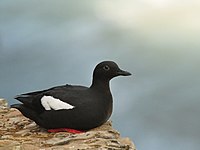
Photo from wikipedia
In wild vertebrates, several species exhibit eumelanic color polymorphism with the coexistence of dark and light morphs. The maintenance of such polymorphism suggests the existence of a selective balance between… Click to show full abstract
In wild vertebrates, several species exhibit eumelanic color polymorphism with the coexistence of dark and light morphs. The maintenance of such polymorphism suggests the existence of a selective balance between the morphs and a large body of literature has reported the costs and benefits of darker plumage coloration in birds. Among them, it has been suggested that melanin and dark plumage could entail high energetic costs especially under hot and sunny climates. However, to my knowledge, the thermal constraints of sun exposure have rarely been studied in polymorphic species. Here, we tested the impact of eumelanic plumage coloration on plumage and body temperatures, and evaporative cooling behavior in the polymorphic rock pigeon (Columbia livia). We experimentally exposed light and dark pigeons to direct sun radiation for 1 h while a few birds were maintained in the shade as controls. We found that sun exposure was associated with increased plumage temperature, and this effect was greater for darker pigeons. In addition, we found that sun exposure was also associated with higher cloacal temperature but for dark pigeons only. Finally, light and dark pigeons were more likely to show cooling evaporative behavior when exposed to sun and as their cloacal temperature increases. Altogether, these results suggest that darker pigeons may have a lower ability to cope with heat and solar radiations and that dark plumage can be associated with thermal costs in this polymorphic species.
Journal Title: Journal of thermal biology
Year Published: 2020
Link to full text (if available)
Share on Social Media: Sign Up to like & get
recommendations!